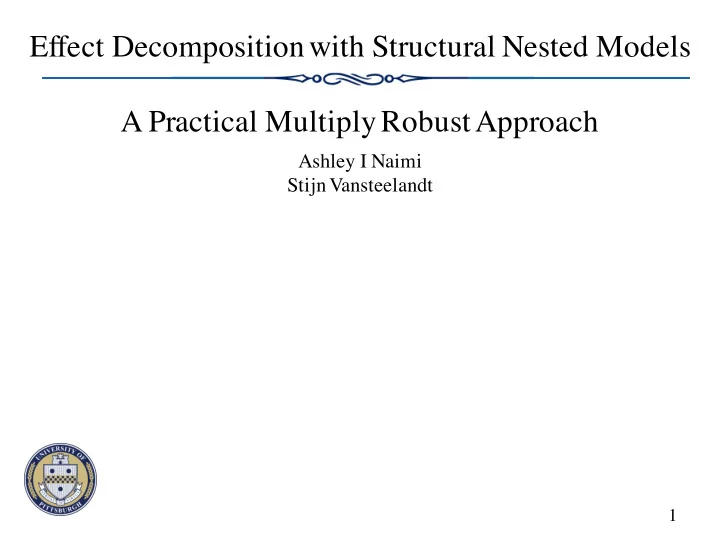

Effect Decomposition with Structural Nested Models A Practical Multiply Robust Approach Ashley I Naimi Stijn Vansteelandt 1
Overview 1. Preliminaries & Review 2. Marginal Structural vs Structural Nested Models 3. Practical MR Estimation of SNMMs 4. Simulation Study 5. Caveats and Conclusions 2
Preliminaries Path Analysis (Wright 1934) Mediation & Moderation (Judd, Baron, Kenny ~ 1980) Pure and Total Direct and Indirect Effects (Robins & Greenland 1992) Natural and Controlled Effects, npSEM, Mediation Formula (Pearl 2001, 2012) Four Way Decomposition (VanderWeele 2014) 3
Preliminaries Natural Indirect Effect 4
Preliminaries Natural Direct Effect 5
Preliminaries Controlled Direct Effect 6
Preliminaries 7
Identifying Natural Effects 8
Identifying Controlled Direct Effect 9
MSM for Effect Decomposition • Models for average of potential outcomes • Estimated (usually) via inverse probability weighting • Outcome and mediator model may be required • Easily fit in standard regression • IPWs obtained by modeling exposure & mediator density VanderWeele 2009 Epidemiol . 20(1):18-26 10
Inverse Probability Weighted MSMs • Highly variable weights • No effect modification by past time-varying covariates • Correct specification of entire exposure / mediator density • Current conventions limit to single robustness 11
G Estimation of SNMMs • Highly variable weights not a problem • Effect modification by past time-varying covariates • Correct specification of exposure / mediator density moment • Double and multiple robustness 12
Objective Develop a modified direct and indirect effect g estimator that can be implemented using standard software routines 13
Approach Propensity scores for the mediator and exposure: Vansteelandt and Joffe 2015 Stat Sci . 29(4):07-31 14
Linear and Log-Linear SNMMs 15
Estimation of a linear SNMM: Step 1 16
Estimation of a linear SNMM: Step 2 e Y = Y − ˆ ψ 2 M − ˆ ψ 3 XM 17
Estimation of a linear SNMM: Step 3 18
Estimation of a linear SNMM The estimated coefficient for X is a multiply-robust estimate of the controlled direct effect when M = 0. It is unbiased (consistent) if: 1. either the propensity score model for M is correct OR the model for Y (in step 1) up to but excluding the propensity score terms is correct and, 2. either the propensity score model for X is correct OR the model for the transformed outcome tilde Y (in step 3) up to but excluding the propensity score term is correct 19
Estimation of a linear SNMM 20
Estimation of a log-linear SNMM: Step 1 ψ (1) ψ (1) ˆ and ˆ 2 3 21
Estimation of a log-linear SNMM: Step 2 exp( − ˆ ψ (1) 2 M − ˆ ψ (1) 3 XM ) This model must also be weighted by ψ (2) ψ (2) ˆ and ˆ Giving us “next step” estimates 2 3 Iterate this until 22
Estimation of a log-linear SNMM: Step 3 Y = Y exp( − ˆ ψ 2 M − ˆ e ψ 3 XM ) 23
Estimation of a log-linear SNMM: Step 4 � E [ e Y | X, C 1 ] = exp ψ 1 X + γ 0 + γ 1 C 1 ψ (1) ˆ 1 24
Estimation of a log-linear SNMM: Step 5 exp( − ˆ ψ (1) 1 X ) This model must also be weighted by ψ (2) ˆ Giving us a “next step” estimate 1 ψ ( j ) ψ ( j − 1) | ˆ − ˆ | ≤ 1 . 0 × 10 − 6 Iterate this until 1 1 25
An iterating algorithm SAS macro 26
Simulation Study: Data Generation All iid binary (Bernoulli) RVs Continuous mediator Strong exposure-outcome confounding Strong post-treatment mediator-outcome confounding X X X E ( Y x 0 ) = P ( Y | X = x,M = 0 , Z, C XY , U ) U C XY Z P ( Z | X = x, U ) P ( C XY ) P ( U ) 27
Simulation Study: Analysis Methods: Inverse probability weighting (MSM) Structural Transformation Method (ST) Modified G Estimation (mGE) Scenarios: All models correct Exposure/Mediator models mis-specified Outcome models mis-specified Results: Distribution of point estimates from 10,000 samples Mean and SD of point estimates Convergence of the iterative approach 28
Simulation Study: Results 29
Simulation Study: Results 30
Simulation Study: Results 31
Simulation Study: Results 32
Convergence Results: All Models Correct 33
Convergence Results: Exposure/Mediator Mis-Specified 34
Convergence Results: Outcome Mis-specified 35
Caveats • Simplified SNMMs in this talk • Asymptotically equivalent to Robins’ g estimation 36
Conclusion Use of g estimation has been relatively infrequent despite many advantageous properties Our modified multiply robust g estimator extends the range of approaches one can take for effect decomposition and direct effect estimation 37
Effect Decomposition with Structural Nested Models A Practical Multiply Robust Approach Ashley I Naimi Stijn Vansteelandt Thanks to: , Ya Hui Yu Gabriel Conzuelo Loren Schleiden ashley.naimi@pitt.edu
Recommend
More recommend